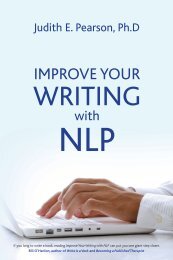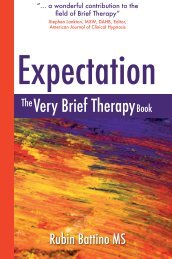22 | A2 PSYCHOLOGY: THE STUDENT’S TEXTBOOK4. Divide the result from step 3 by the number ofvalues in your data set.5. Take the square root of the figure you calculatedin step 4.Range1. Find the largest <strong>and</strong> smallest values in yourdata set.2. Take the smallest from the largest.Semi-interquartile range1. Put your values in order (smallest to largest).2. Count up how many values you have. Call this‘N’.3. Calculate N+1 <strong>and</strong> divide by 4. Call this ‘L’.4. In your ordered data set, find the number atposition L.5. Calculate N+1, multiply it by 3, then divide itall by 4. Call this ‘U’.6. In your ordered data set, find the number atposition U.7. Take the value in step 4 from the value in step6.8. Divide the result of step 7 by 2.When you take each step at a time, the mathematicsare not too difficult at all. It’s important to beorganised when making these calculations. Makesure your working-out paper does not becomemuddled, <strong>and</strong> that you keep track of the values. Ifyou do that then life will be much simpler.EquationsBefore writing this we asked as many students as we could what they would find useful, <strong>and</strong> what they wouldlike, when learning about research methods <strong>and</strong> statistics. 82% of them told us that they would like to avoidequations at all costs, <strong>and</strong> 87% said that learning how to use equations would be extremely useful. It is clearthen that most students hate equations <strong>and</strong> at the same time most of them think that it’s a good idea thatthey know how to use them. How right they are!∑ (x – x) 2NThis is the equation for working out st<strong>and</strong>ard deviation. The trick with these things is to underst<strong>and</strong> whateach part means, <strong>and</strong> to do one thing at a time. Let’s split it up into its parts <strong>and</strong> then work out how to use it.Armed with your knowledge of the more common symbols used in mathematics, let’s take a look at the equationagain. Look at the line right in the middle for the moment:∑ (x – x) 21. Calculate the mean value (x) of your data set.2. Take your value (x) <strong>and</strong> subtract from it the mean of the data set (x).3. Multiply what you get in step 2 by itself.4. Do this for all of the values in your data set in turn, writing the result down each time. If you have 20values then you will end up with 20 numbers.5. Now add up (∑) all the numbers you calculated in step 4.You may get a negative number in step 2, but that doesn’t matter at all, because once you’ve squared it (multipliedit by itself) you always have a positive number, much easier to deal with. Tedious <strong>and</strong> some might evensay very boring, but not terribly complicated so far. The rest is even simpler.6. Take the total you get in step 5 <strong>and</strong> divide it by the number of values in your data set (N).7. Put this number into your calculator, find the square root button marked √ <strong>and</strong> push it. The result you getis s, the st<strong>and</strong>ard deviation for your data set.If you do one thing at a time, equations are not very complicated at all. The best thing to do is just practisea little, take your time <strong>and</strong> be organised. Get to know what each part of the equation means. It’s a bit likelearning another language, but there’s not too much to know. Each equation uses pretty much the sameinformation in a slightly different order. If you know the basics, any equation is child’s play. Oh, <strong>and</strong> if you feela little daunted by this type of thing, so do 82% of our students: <strong>and</strong> some of them are at university – you arenot alone.Extract from A2 Psychology: The Student’s Textbook © <strong>Nigel</strong> <strong>Holt</strong> <strong>and</strong> <strong>Rob</strong> <strong>Lewis</strong> ISBN: 9781845901004 www.crownhouse.co.uk
DATA ANALYSIS AND REPORTING INVESTIGATIONS | 23Probability <strong>and</strong> significanceWe’ve already let you in on a few secrets aboutstatistics. Here’s another. All they are for is forshowing that your result didn’t occur by chance.That’s pretty much it. Don’t let anyone fool youinto thinking they are any more complicated thanthat. When we do some statistics all they give usafter we’ve finished adding, multiplying, dividing<strong>and</strong> things is a single important number, which werefer to as ‘p’. It st<strong>and</strong>s for ‘probability’.The p value gives us an idea of how likely it isthat our results happened by chance or not. Thep value can be anywhere between 0 <strong>and</strong> 1. A p of1 means that something is definitely, absolutelygoing to happen. For instance, there is a probabilityof 1, an absolute certainty, that in the UKChristmas Day will fall on December the 25th. Ap of 0 means that something is never ever goingto happen. For instance, there is a probability of 0that this book will turn into a badger.The nearer to 1 your value of p is, the more likelyit is that the results happened by chance. Thesmaller the value of p, the more likely it is thatwe can confidently accept our hypothesis, <strong>and</strong>reject our null hypothesis. A p of 1 means that weare 100% certain that something will happen bychance. A p of 0.9 means that we are 90% certainthat something will happen by chance. A p of 0.8means we are 80% certain that something willhappen by chance <strong>and</strong> so on. The smaller the pthe less likely it is that something will happen bychance. Remember:Small p – GoodBig p – BadIf we can reject our null hypothesis we can say thatour results were ‘significant’. By this we mean thatour findings did not occur by chance. Statistics letus measure how ‘significant’ our results are. Statisticaltests are used to analyse the data gatheredin research to tell us the p value (we will describethese tests in more detail shortly). The smallerthe p value, the more significant the result. Forexample, the statistical analysis might tell us thatwe have a p value of 0.02. This is the significancelevel. When we report ‘p’ in research papers <strong>and</strong>books it is more often than not written like this:p

















